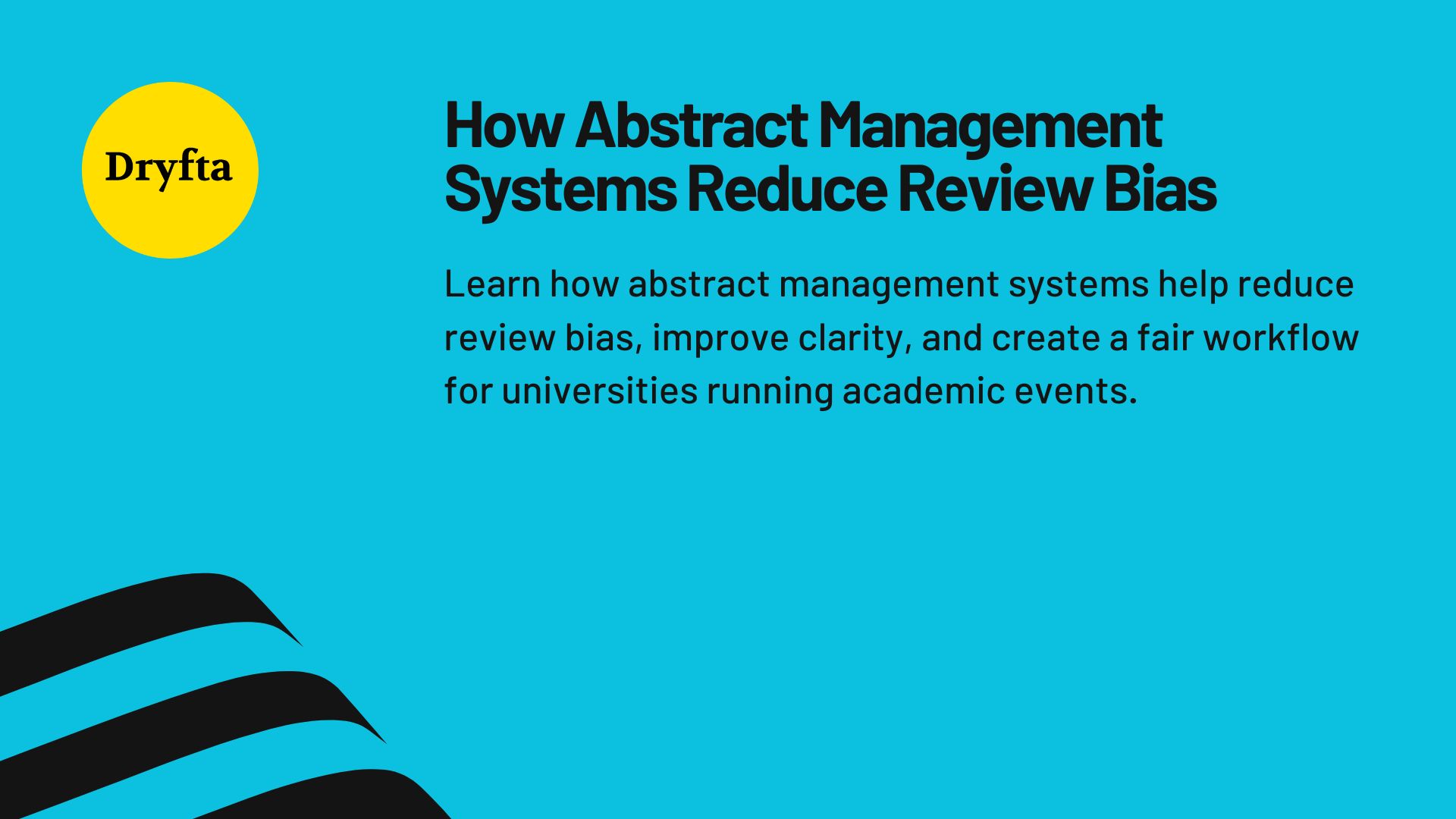
Every conference depends on a fair review system. While reviewers do their best to be objective, small biases still slip in and influence the ultimate decision about whether to accept the abstract. A simple word, a known name, or a familiar topic can shift how a reviewer scores an abstract. Such instances might feel harmless, yet they build up and change who gets accepted.
Academic teams want a fair process because authors trust the system when every abstract gets the same chance. Review bias makes that hard, and the problems grow when reviews come in late or follow a different set of rules. A single unclear line or missing detail will change the score drastically.
However, tools that help reduce these challenges are available. Abstract management systems support teams with simple steps that ensure fair reviews. Tools provided through an AMS help remove personal details, guide scoring, and direct each abstract to the correct reviewer. Overall, these tools work together to allow reviewers to focus on the content of the abstracts rather than the identity of the authors.
Ultimately, having a fair review process results in a fairer overall event. Authors feel supported, reviewers feel safe, and the final program reflects real quality. This guide outlines the common types of review bias and the simple ways Abstract Management Systems keep the process fair from start to finish.
What Review Bias Means in Academic Events
Review bias happens when a reviewer’s score changes for reasons that do not relate to the abstract. Large academic events face this often because many reviewers come from different fields and have different habits. For example, a slight difference in writing style (for example, tone, grammar) can cause a significantly higher or lower rating.
Common forms of review bias
-
- Affiliation Bias
Affiliation bias shows up when a reviewer gives a higher score because the author comes from a well-known university. Sometimes the score drops when the author comes from a lesser-known institution. Reviewers do not do this intentionally. It happens because people link the name of an institution with quality.
- Affiliation Bias
-
- Reputation Bias
Reputation bias happens when a reviewer judges the abstract based on who the author is. An author who has a good reputation receives a favorable review. A new author with little to no reputation gets more doubt. Even simple name cues can shape the score.
- Reputation Bias
-
- Language Bias
Language bias affects the work of authors whose native language is not English. Reviewers may mark an abstract with a lower score if the writing feels less smooth.
- Language Bias
-
- Topic Familiarity Bias
Topic familiarity bias shows up when reviewers score higher in areas they know well and lower in fields they find new or unclear.
- Topic Familiarity Bias
-
- Strictness or Leniency Bias
Strictness or leniency bias refers to reviewers who are always strict or always generous. The reviewer may not be familiar with this pattern. It forms from habit, workload, or personal comfort.
- Strictness or Leniency Bias
-
- Confirmation Bias
Confirmation bias shows up when a reviewer looks for details that support what they already believe. Experiments with identical abstracts framed in different ways have shown this effect.
- Confirmation Bias
-
- The halo and horn effect
The halo and horn effect occurs when a reviewer judges the entire abstract based on a single strong or weak detail. A clear title or seamless writing can create a halo that makes everything seem stronger, while a small flaw like a typo can create a horn effect that lowers trust in the entire work.
- The halo and horn effect
How Abstract Management Systems Reduce Bias
Abstract Management Systems reduce bias by keeping the review flow clear and consistent. Large conferences often have many reviewers, and each reviewer has their own unique reading style. Such differences can shift how they score a paper. An AMS reduces this by ensuring that each abstract occupies a single clean space and that each reviewer follows the same steps. The setup stays simple, and the layout stays calm, so reviewers focus on the work.
AMS tools also support fairness because each abstract appears in the same format. Reviewers will be able to see clear texts and simple labels, so that they don’t waste time opening files or fixing layout issues.
Blind Review Setup
Blind review hides the authors’ identities along with their institutions before reviewers view the abstract. The goal is to keep the focus on the work. When identity details are left out, the reviewer reads the abstract with fewer personal shortcuts. Blind review also reduces the pressure that comes from seeing well-known names. Reviewers see the same layout and the same type of document for each submission, which helps them judge fairly.
Standard Scoring Rubrics
Standard scoring rubrics give reviewers clear steps to follow when they judge each abstract. Organizers set one rubric scale with fixed points for clarity, relevance, method strength, and impact. Reviewers use the same scale, so the scoring feels steady and fair.
A shared rubric also lowers confusion because reviewers do not have to guess which parts deserve more weight. The abstract management system holds the complete rubric inside the review screen, so the rules stay visible at every step.
Conflict of Interest Checks
Conflict of interest checks are conducted before the scoring begins. Reviewers must disclose any close ties with an author, including working in the same group, sharing grants, or having recent joint papers, to ensure personal ties do not affect the scoring. If a conflict appears, organizers move the abstract to another reviewer. Conflict of interest checks also lower bias from relationships. It supports clean and trusted results in selection rounds.
Multiple Reviewers for Fair Scoring
Multiple reviewers per abstract help keep the process fair. When more reviewers read the same work, the influence of any one person’s personal taste or bias weakens.
If one reviewer is harsh or lenient, the others’ judgments might balance the score. The team then uses an average score to maintain stability in the results. A lead reviewer or panel judge guides the process and is responsible for reviewing the reviewers’ scores and any additional comments they have made about the abstract.
Tracking Patterns in Scores
Tracking score patterns gives teams a clear view of how reviewers judge each abstract. An abstract management system collects every score in one place so that teams can see trends right away. When a reviewer often gives very high or very low marks, the system highlights it. When certain topics show sharp changes, the team can take a close look and ask why.
Tracking score patterns also helps organizers explain decisions in an uncomplicated way, which builds trust across the event. Journals and conferences that use score audits report better fairness and fewer complaints after they add review tracking.
Clear Review Instructions
Clear review instructions help the universities guide every reviewer throughout the scoring process. Each abstract is reviewed using the same evaluation steps. The reviewers will have a defined evaluation method for reading the abstract, scoring each part, and adding short notes. The clear guidelines also help staff members monitor the review’s progress and identify errors earlier, rather than later, thereby reducing delays.
What Universities Gain From Abstract Management Systems
Abstract management systems give universities a clear idea of how to judge abstract. Using a common set of rules, reviewers can assess and judge submitted work fairly and consistently, helping them avoid lengthy discussions about why one abstract moved forward while another was rejected. On top of this, abstract management systems foster trust because authors know their submissions are being reviewed honestly and thoroughly.
Abstract management systems will also help universities in managing events. Reviewers will understand their tasks, and in turn, authors receive clear feedback.
Key Advantages
-
- Clear tracking for all abstracts
- Simple tasks for reviewers and staff
- Higher trust in the workflow
- Fewer errors and delays
- Stronger academic reputation for order and transparency
A fair review process based on consistent evaluation, unbiased reviews, and transparent score reporting will enhance each component of a university’s academic event.
Final Thoughts
Strong abstract management systems simplify the review process at universities by giving reviewers one place to handle all parts of the abstract review without losing time or clarity. When every abstract is stored in the same clean, organized space and follows the same flow as every other abstract, the entire abstract review process is greatly simplified for everyone involved.
Since Dryfta meets all the objectives listed above, universities now have a simple way to organize all abstracts from submission through the review process. The platform also helps teams work with less stress because the setup is simple to use and simple to maintain. Ultimately, with the right support, your abstract review process will be fair and easy for all parties.




